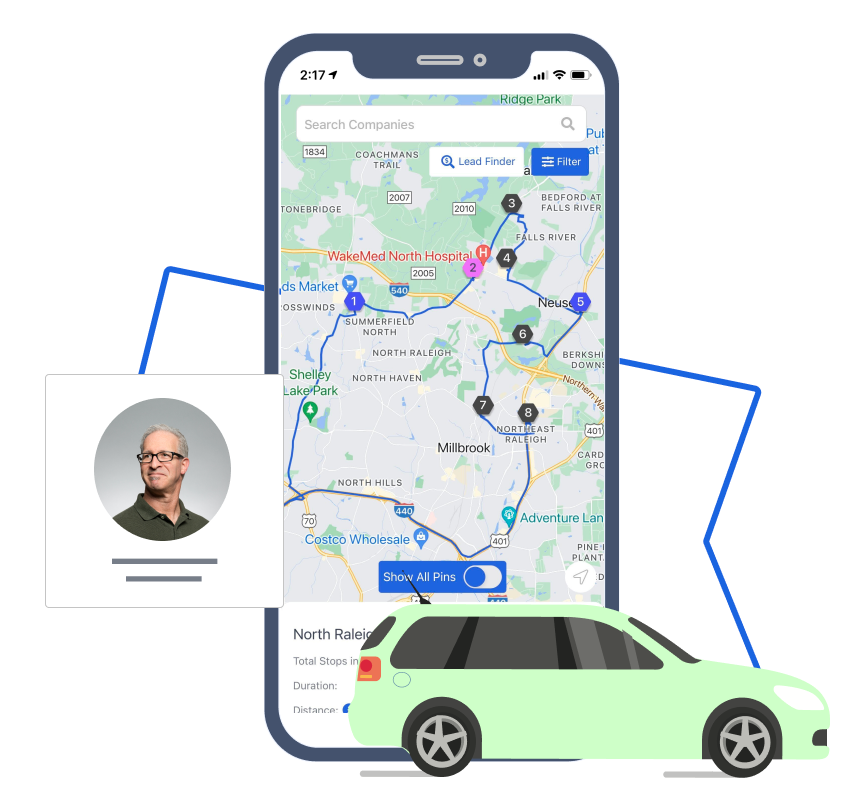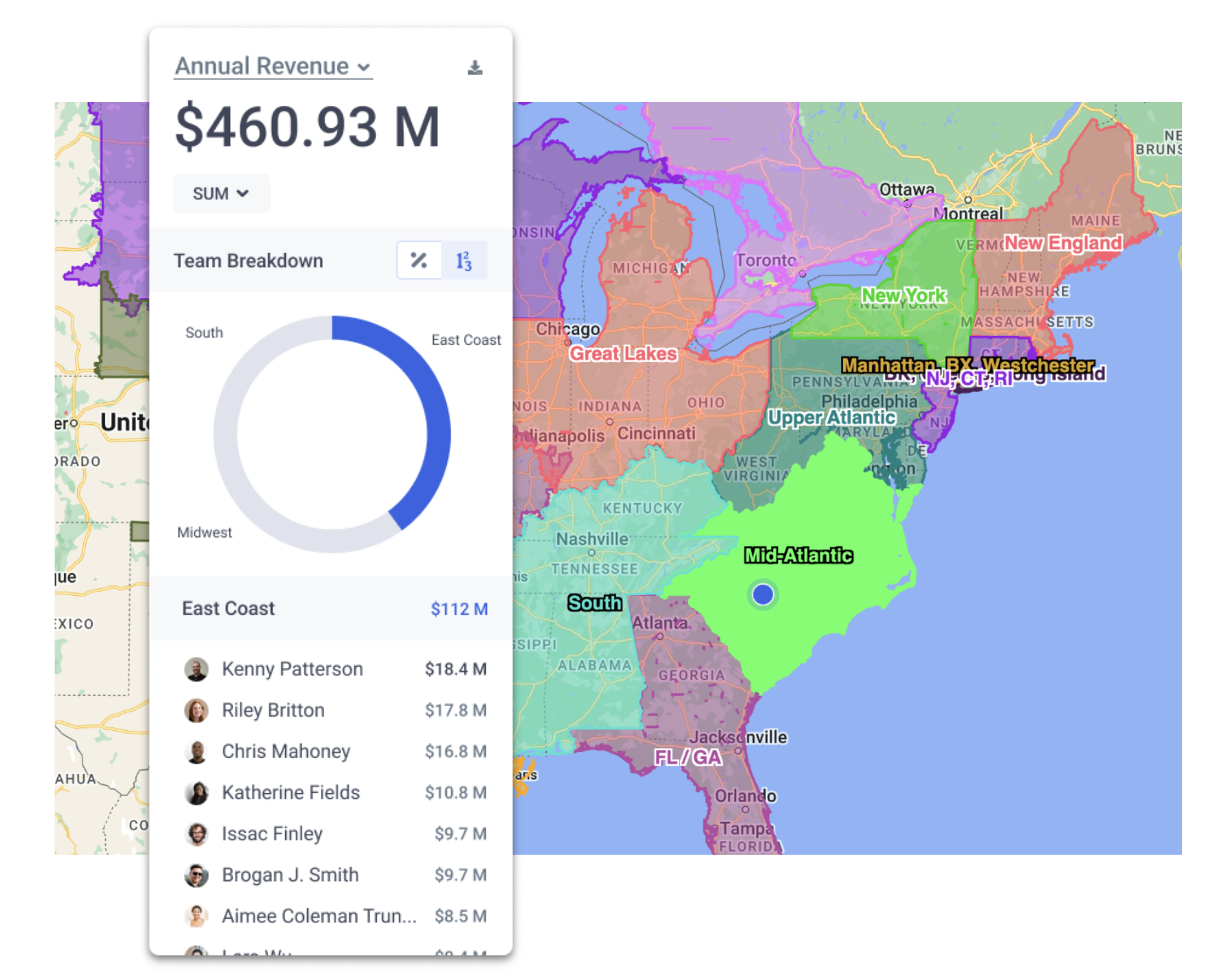Building a sales process for outside sales:
What gets measured gets done
As a new outside sales rep, nothing is more frustrating than managing a territory without a plan. Just ask Joe McDonald, Executive Vice-President at Jasper Engines and Transmissions.
When he was first hired in the outside sales rep role, he wasn’t given much more than a spreadsheet and a “Go get ‘em, Tiger.” Within 6 months, he was burned out and at the end of his rope.
“I’d been very frustrated with the job. Not knowing where I needed to go, not being organized, I just felt lost. So I’ll never forget calling up my regional manager and saying, ‘You don’t need to pay me. I’m taking off a day. I’m gonna get un-buried, and I’m gonna figure this thing out.’”
It doesn’t take a dedicated sales operations professional to tell you that a sales process is important. Or that an effective territory management plan is crucial to an outside rep’s success. And yet, most of the companies we talk to don’t have a defined sales process to help their reps succeed.
It’s not that they don’t care or don’t realize its importance. It’s that they don’t know where to start and then how to implement it across the sales organization.
Let’s solve that. We’ll follow Joe McDonald’s journey from start to finish on how he built a sales process for Jasper Engines and Transmissions.

“Our company has processes, we’re a manufacturing company.
And when we started looking at outside sales, we really carried those processes for manufacturing to outside sales.”
Start with your best reps
“I bought a map and started to break down my territory into four quadrants. And I spent a week in each quadrant in my entire territory. And that allowed me to be much more efficient.”
The thing that got Joe McDonald started with territory management 30 years ago is still what drives Jasper’s sales process today. Every outside sales rep inside Jasper has a territory that’s broken down into four quadrants. Inside each quadrant are accounts labeled 12s, 6s and 4s. These designations represent the number of times per year a rep is supposed to be face-to-face with that account.
From here, each face-to-face visit is broken down into work instructions.
- Start with a sales plan outline. The questions you want to ask, the products you want to discuss and the goal of the meeting.
- Prep your presentations. Have your presentations ready to go and know where you want to pause and ask clarifying questions.
- Define next steps. Make sure you and the customer are on the same page for post-call follow-up.
- Log the outcomes. What gets measured gets done. And Jasper requires all sales reps to log the outcomes of each face-to-face visit.
These processes all stem from Jasper’s main business: manufacturing.
As Joe says, “Our company has processes, we’re a manufacturing company. And when we started looking at outside sales, we’ve really carried those processes for manufacturing to outside sales. So, when somebody is interviewing with us, I tell them we’re in production sales. Because, we’re bringing you for your personality but you’re gonna have to fit into a system of selling that we know is very, very, successful.”
Each aspect of this sales process is defined by what makes a rep successful. Changes to presentations, outlines or sales scripts are all driven by what the top reps are doing to continue driving business results.
The Jasper Customer Visit Plan
Start with a sales plan outline
Prep your presentation
Define next steps
Log the outcomes
Process breeds long-term results
Why do it this way? Looking at it outlined like this, it seems too easy. But, in practice, this kind of process is revolutionary. Most outside sales organizations don’t have this much process built into their rep’s day-to-day.
But, the important thing is that Jasper’s sales process didn’t evolve overnight. They’re constantly honing each aspect of the process. All to help reps be more successful. Because when the rep is successful, Jasper is successful. So, the point of the sales process is to give every outside sales rep inside Jasper a blueprint for success.
Joe explains, “From the time you start your day, how many calls you make, to how many presentations you’re making to who you’re calling on: it’s all broken down into those processes.
Some people say, ‘That’s micromanagement. That’s big brother.’ It’s been described that way in a negative light. But again, if you have processes to fall back on, that limits failure. If there’s failure, you can easily go back and find out where that failure is.
At the end of the day, if you’re doing all those processes, and you’re struggling, I’ll come out, get in that car, and we’ll figure it out. Because if it’s not the process, it’s something else.”
Long-term, this well-defined sales process breeds success even when times get hard. Right now, the automotive aftermarket is doing well. But that never lasts forever. So, Joe and his regional leadership team needs to stay vigilant about the process.
Joe likes to say, “Sales hides all sins.” So, when a salesperson is doing well, they don’t expect a lot of pushback or coaching. And in some organizations, leadership might be wary to push these top performers too hard. But it’s going to get difficult again.
And Joe maintains that the outside sales reps who stick to the process rise to the top when sales gets harder. By following the processes day-in and day-out, sales reps build up their process muscles. So that when economic turbulence abounds, they have the confidence in place to fall back on the process and trust it will continue to produce results.

“At the end of the day, if you’re doing all those processes, and you’re struggling, I’ll come out, get in that car, and we’ll figure it out.
Because if it’s not the process, it’s something else.”
Measuring the metrics that matter
Jasper’s reps are held accountable to 13 good calls per day. What’s meant by a “good call” depends on the account and the desired outcome. Sales plans, outlines, presentations are all metrics these calls are measured against.
But what about the leadership team? Jasper’s regional managers and vice-presidents are held to processes and metrics as well.
For regional managers, they’re filling the player-coach role. Still held accountable to face-to-face visits, though much less than a typical rep, and they’re held accountable to ride-alongs.
And true to Joe’s word, ride-alongs have work instructions too. Regional managers have specific metrics they need to record during a ride-along.
- Were you in the field with a decision maker?
- How many ride-alongs per week and month?
- What products are being discussed with which customers?
These all contribute to how regional managers can be better coaches, while also giving Vice Presidents and Joe a better pulse on the market.
“We sell gas engines, transmissions, differentials, diesel engines, and we want to know what reps are talking about. I guarantee everything is going to go back to what your reps are talking about. Kind of funny, right? What you talk about is what you sell.
So, when we go blitz an area, and we say, ‘Let’s push transmissions.’ Guess what inquiries we start getting? Transmissions. So we’re tracking that now to understand how to start reps moving in the right direction.”
In the end, this all stems from Joe’s signature phrase: What gets measured gets done. When a company has trackable metrics in place and clearly communicates why those metrics are valuable, then the sales process is measurable and scalable.

When fear beats best practices
“Where I see a lot of sales leaders fail is fear.
They are putting so many things in place and they think they may lose a rep. But you have to put this in place. And what it comes down to is best practices. Look at what your top reps are doing. Go ride with them, what are they doing, take one or two of those things and bring that into the fold across your team. And that’s where you get the buy in.
‘Hey, guys, our top three reps are talking to customers about [this] once a week. They’re starting their days with these types of calls and they’re asking these types of questions.’ Create best practices and then hold them accountable to do those. We do.”
Joe McDonald realized quickly that the plan needed to be valuable bottom-up, or starting with the rep and moving up to the leadership team. Because when the rep sees value, they know the organization is doing this to help them first, not just increase the company’s bottom line.
For Jasper, this meant using a CRM to measure the process that was built for the outside sales rep first. Map My Customers was an easy decision. And the way they implemented this new CRM was also focused on the rep.
“What we did from a buy-in perspective is we had some of our best reps pilot Map My Customers first. Then, we tweaked a bit before we brought it in and said ‘This is what these reps like about it. That’s why we’re bringing it in.’
And the other piece of it we shared is MVP: minimum viable product. What we put out replaced what we had at minimal viable product, but we knew it would get better. And that’s what we’ve shared with our team. We’re going to tweak this and make it better as we go along.”
Joe knew picking a CRM provider that was a true partner throughout the implementation process was key. And Map My Customers has checked every box for the Jasper team. Map My Customers is now deployed across the entire Jasper sales organization.
And as we continue to talk about best practices, just choosing a rep-first CRM isn’t enough.
Joe made it clear to his team, “This is our CRM, you must enter your call into this product. So it’s mandatory for us.”
Building a system that works for your reps is step one, mandating it is step two and then continuing to evolve it are steps three and beyond.
As far as evolving the product for Jasper’s sales process, Joe says, “One of the best use cases is that our sales leaders now have the ability to put in a coach’s note live. So they can see that a rep saw Jim’s Automotive, and he’s going to be going back in there later this week. He can go right into that account and say, ‘Hey, Bill, I noticed you said you talked about this last time, try this this time.’
So when you start to do those types of things, and everyone gets something out of it, buy-in happens a lot more.”

“What we did from a buy-in perspective is we had some of our best reps pilot Map My Customers first. Then, we tweaked a bit before we brought it in and said,
‘This is what these reps like about it. That’s why we’re bringing it in.’”
When the rep wins, the company wins
When Joe McDonald first came to Jasper, he had nothing but a list of accounts and a quota to fill. For most new outside sales reps, this is the norm. But it doesn’t have to be.
Building a defined, measurable sales process doesn’t have to be a months-long endeavor focused on perfection. It just needs to give your reps the system they need to better manage their territory. For Joe, this meant copying the process of his best reps and pushing that out to the sales team in a value added way.
With the bones in place and his team adopting the new process, Joe and the Jasper leadership team began putting measurable metrics in place to track each stage. These metrics all answered the question, “How can we keep helping reps be more successful in the field?”
Finally, Jasper’s team has adopted the sales technology necessary to track these metrics in a way that benefits the rep first and then the management team. Before the rep plans their day, they know exactly who they need to see. Now, it’s a matter of what they need to discuss, what they’ll present to the customer and how they’ll follow-up. The administrative burden is lifted, so reps can do what they’re great at: building better customer relationships.
And when reps are building better customer relationships, Jasper benefits not only from a financial perspective, but as a brand. Jasper is known for its well-prepared, knowledgeable outside sales team. Customers across the industry trust Jasper’s reps to challenge them and drive results for their businesses.
If you’re ready to start measuring your sales process using the metrics that matter, let’s talk.